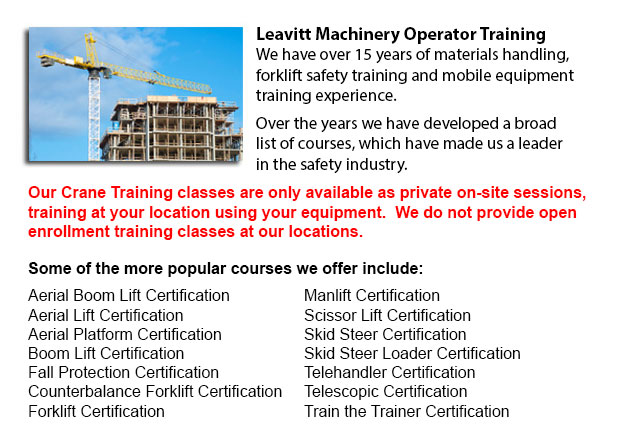
Overhead Crane Safety Training Burlington - Overhead crane safety training equips operators with knowledge and skills regarding crane safety measures, materials handling, accident avoidance, and machinery and stock protection. Trainees would learn the types of overhead cranes, their capabilities and their uses in different industry environments. For operators who are licensed and trained, the shift in liability moves to the operator from the company. Thus, the program emphasizes individual operator duties.
Overhead crane safety training instructs operators in the correct ways for carrying out checks. Two kinds of pre-shift inspection are the in-depth inspection and the walk-around inspection. These are critical daily routines that must be logged. Properly recorded pre-shift checks help to protect the company from liability in case of an accident. Pre-shift inspections also prevent costly repairs, accidents and damage. Operators learn how to designate a particular person to handle inspections, how to maintain the log book and how to report problems.
Inspections should be carried out on a regular basis and documented right. The following must checked while watching for usual problems: hooks for cracks, increases in the throat opening, hoist ropes for corrosion, degree of twist, worn wires, loss of diameter, broken wires, bird caging and kinks, chemical and heat damage; chains for nicks and gouges, cracks and corrosion, twists, distortion, excessive wear, pits, stretching, damage caused by extreme heat.
The operator would get to learn the right methods about correct rigging measures. The process of rigging includes the understanding of the manufacturer's data plate, determining the weight of materials to be lifted, selecting the gear, and using safe practices to secure the load. The course cover in detail the following: safe working loads, and the capacities of ropes, chains, shackles, slings and hooks.
It is vital to know who may use the cranes at your facility, physical requirements of the job, and operator credentials required for specialized job and permits. Safety is a top priority when operating near pedestrian traffic.
Safe crane operation involves responsibilities like for example undertaking visual inspections, checking for hydraulic leaks, testing the controls, checking the safety guards, examining the hook and hoist rope, braking mechanisms and limit switches. Proper reporting methods are critical. These topics are all covered in depth in the program.
The course likewise consists of the right lifting and moving procedures with hoists and cranes. Operators would likewise learn right hand signals. Training involves how to raise the load, attach the load, set the load, unhook the slings and abort a lift.
Moving the load includes a few steps: stopping and starting procedures, controlling and guiding the load, working with signals and observing working conditions. Operators must know how to proceed in the event of a power failure. The course covers methods for removing the slings and lowering the load, parking the crane, storage equipment, and securing an indoor and outdoor crane.
-
Order Picker Training Burlington
Order Picker Training Burlington - Order picker's enables warehouse employees to lift pallets using forks. Also called a stock picker, this particular electrically-powered equipment is similar to a forklift except that an order picker is likewise uti... More -
Crane Certification Burlington
Crane Certification Burlington - The Crane Certification training program includes content recommended by industry regarding the efficient and safe operation of cranes. Trainees would learn the following: how to identify cranes and their component pa... More -
Overhead Crane Training Burlington
Overhead Crane Training Burlington - The overhead crane is a piece of equipment which can lift and move huge, heavy objects which can't be handled by hands. Typically, overhead cranes are fixed in place. These equipment are capable of moving huge vol... More -
Aerial Lift / Boom Lift / Man Lift / Scissor Lift Training in Burlington
Lift tables or scissor lifts could elevate both people and goods vertically. They are normally used in construction, commercial and industrial environments. Commonly, the use of a scissor lift is to lift and lower supplies from one floor of a job loc... More -
Telehandler Operator Training Burlington
Telehandler Operator Training Burlington - Telescopic Handler forklifts or telehandler forklifts are usually found on construction places and their popularity continues to rise. The versatility of telehandler forklifts ensures that they are a valuabl... More -
Forklift Training Classes Burlington
Forklift Training Classes Burlington - Forklift are heavy pieces of industrial machines that are made use of in transporting and the handling of merchandise and materials. They are often known as Lift trucks and are found in all sorts of businesses.... More -
Boom Lift Training Burlington
Boom Lift Training Burlington - Aerial platforms or also known as elevated work platforms are devices that allow workers to perform tasks and duties at elevated heights that would not be otherwise accessible. There are a variety of aerial lifts avail... More -
Bucket Truck Training Burlington
Bucket Truck Training Burlington - The Vehicle-Mounted Aerial Work Platform or also called bucket truck training program is intended to decrease the risk of incident and personal injury while working in close proximity or with bucket trucks by effici... More

Forklift Training Burlington
TOLL FREE: 1-888-254-6157
Burlington, Ontario
forklifttrainingburlington.com
Email Us
About Us


